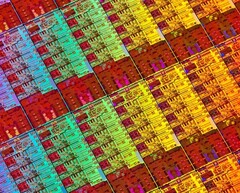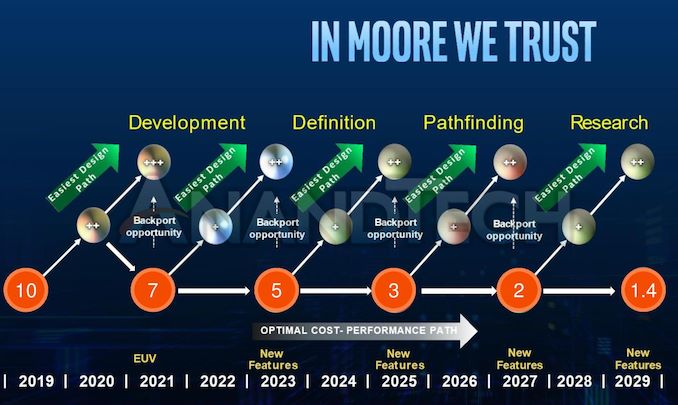Intel used to be among the top companies that push for a consolidated transistor miniaturization schedule up until a few years ago when the company missed its target for the 10 nm node and had to push delay it to 2019. The schedule problems are related to the shortages that have been occurring for the past two years, yet Intel is still confident that the next 10 years will not be plagued with such supply-related problems and, by 2029, everything should go according to Moor’s law, with a milestone die shrink programmed every 2 years. Will this be enough to keep up with AMD’s aggressive die shrink schedule?
At the IEEE IEDM convention this year, Intel proudly presented its 10-year schedule that includes five major node upgrades, excluding the 10 nm node that Intel is already partially employing. The exact node sizes were not actually mentioned by Intel, and they were later provided by ASML. Thus, the next node upgrade will occur around 2021 and will bring the 7 nm EUV manufacturing process. Further down the line, we find the 5 nm process scheduled for 2023, 3 nm scheduled for 2025, 2 n for 2027 and 1.4 nm for 2029. Now, it is known that silicon transistors cannot really be shrunk beyond 2 nm, so Intel will employ “2D self-assembly” materials in this case.
As with previous die shrinks, Intel will allow for iterative + and ++ versions in-between each major upgrade in order to refine the performance for each node. Intel learned its lesson with the shortage problems and wants to avoid this sort of problems by implementing a back porting feature. Back porting essentially allows Intel to design chips for a specific node, and, if unforeseen delays incur, those chips can be remade on a previous ++ iteration in the same timeframe. Intel's road-map slide shows that all ++ iterations of previous nodes coincide with the each consecutive node upgrade.
For now, Intel has only finalized plans for the 7 nm and 5 nm nodes and everything beyond 2023 is still in the research phase. Before jumping to other materials, Intel will most likely use nano-sheets and nano-wires. It will be interesting to see what materials will be chosen by each major transistor producer beyond 1 nm.
I first stepped into the wondrous IT&C world when I was around seven years old. I was instantly fascinated by computerized graphics, whether they were from games or 3D applications like 3D Max. I'm also an avid reader of science fiction, an astrophysics aficionado, and a crypto geek. I started writing PC-related articles for Softpedia and a few blogs back in 2006. I joined the Notebookcheck team in the summer of 2017 and am currently a senior tech writer mostly covering processor, GPU, and laptop news.
> Expert Reviews and News on Laptops, Smartphones and Tech Innovations > News > News Archive > Newsarchive 2019 12 > Latest Intel roadmap shows 1.4 nm CPUs scheduled for 2029
Bogdan Solca, 2019-12-11 (Update: 2019-12-11)












